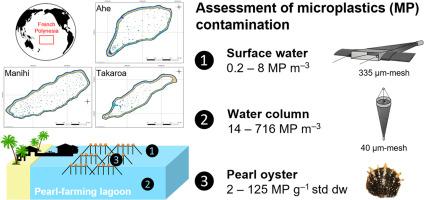Journal of Hazardous Materials ( IF 12.2 ) Pub Date : 2021-06-11 , DOI: 10.1016/j.jhazmat.2021.126396 Tony Gardon 1 , Maria El Rakwe 2 , Ika Paul-Pont 3 , Jérémy Le Luyer 1 , Léna Thomas 2 , Enora Prado 2 , Kada Boukerma 2 , Anne-Laure Cassone 3 , Virgile Quillien 1 , Claude Soyez 1 , Louis Costes 1 , Margaux Crusot 4 , Catherine Dreanno 2 , Gilles Le Moullac 1 , Arnaud Huvet 3

|
Pearl-farming is the second most important source of income in French Polynesia. However, tropical lagoons are fragile ecosystems with regard to anthropogenic pressures like plastic pollution, which threaten marine life and the pearl oyster-related economy. Here, we investigated the spatial distribution of microplastics (MP) and concentrations in surface water (SW), water column (WC) and cultivated pearl oyster (PO) from three pearl-farming atolls with low population and tourism. Microplastics were categorized by their size class, shape, colour and polymer type identified using FTIR spectroscopy. Widespread MP contamination was observed in every study site (SW, 0.2–8.4 MP m–3; WC, 14.0–716.2 MP m–3; PO, 2.1–125.0 MP g–1 dry weight), with high contamination in the WC highlighting the need to study the vertical distribution of MP, especially as this compartment where PO are reared. A large presence of small (< 200 µm) and fragment-shaped (> 70%) MP suggests that they result from the breakdown of larger plastic debris. The most abundant polymer type was polyethylene in SW (34–39%), WC (24–32%), while in PO, polypropylene (14–20%) and polyethylene were more evenly distributed (9–21%). The most common MP identified as black-grey polyethylene and polypropylene matches the polymer and colour of ropes and collectors questioning a pearl-farming origin.
中文翻译:

法属波利尼西亚珍珠养殖泻湖中的微塑料污染
珍珠养殖是法属波利尼西亚的第二大收入来源。然而,热带泻湖是脆弱的生态系统,因为塑料污染等人为压力威胁着海洋生物和与珍珠贝相关的经济。在这里,我们调查了来自三个人口和旅游业低的珍珠养殖环礁的微塑料 (MP) 的空间分布和地表水 (SW)、水体 (WC) 和养殖珍珠贝 (PO) 中的浓度。使用 FTIR 光谱确定微塑料按其尺寸等级、形状、颜色和聚合物类型进行分类。在每个研究地点都观察到广泛的 MP 污染(SW,0.2–8.4 MP m –3;WC,14.0–716.2 MP m –3;PO,2.1–125.0 MP m –1干重),WC 中的高污染突出表明需要研究 MP 的垂直分布,特别是在饲养 PO 的这个隔间。大量存在的小 (< 200 µm) 和碎片状 (> 70%) MP 表明它们是由较大的塑料碎片分解造成的。最丰富的聚合物类型是 SW (34-39%)、WC (24-32%) 中的聚乙烯,而在 PO 中,聚丙烯 (14-20%) 和聚乙烯分布更均匀 (9-21%)。最常见的 MP 被确定为黑灰色聚乙烯和聚丙烯,与绳索的聚合物和颜色相匹配,收藏家质疑珍珠养殖起源。











































 京公网安备 11010802027423号
京公网安备 11010802027423号